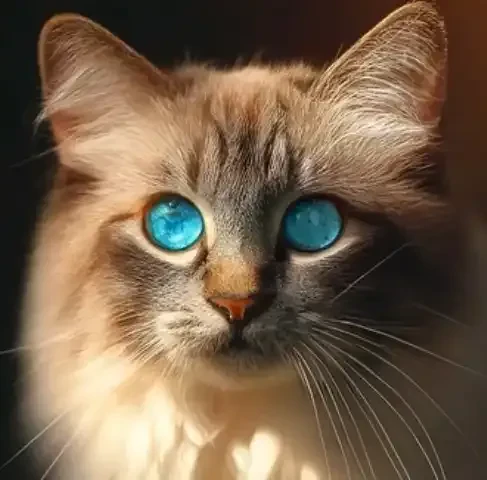Introduction
Have you ever found yourself mesmerized by the enigmatic gaze of a cat, wondering what secrets lie behind those piercing eyes? While we may consider ourselves well-acquainted with our feline companions, the world of cats is far more mysterious and intriguing than meets the eye. From their evolutionary journey to their peculiar habits, cats continue to surprise us with their unique traits and behaviors.
In this article, we embark on a journey to uncover the unexpected facts about our feline friends. Despite our familiarity with cats, there are several surprising aspects of their lives that often elude our understanding. From their evolutionary origins to their extraordinary senses, from their curious communication methods to their bizarre eating habits, cats never fail to astonish us with their complexity.
Through delving into the lesser-known facets of feline behavior and biology, we aim to shed light on the captivating world of cats, challenging common misconceptions and revealing the hidden truths that make these creatures so fascinating. Prepare to be astonished as we unravel the mysteries of your feline friend like never before.
The Evolutionary History of Cats
Cats have walked the Earth for millions of years, leaving their pawprints across the tapestry of evolution. From the ancient forests to our modern homes, the journey of the cat is one filled with adaptation, survival, and transformation.
Overview of Cat Evolution
The story of cat evolution dates back approximately 60 million years to the Eocene epoch, where the first ancestors of modern cats roamed the dense jungles of ancient continents. These early felids, known as proailurines, were small, tree-dwelling mammals with long tails and retractable claws, setting the stage for the emergence of the diverse cat family we know today.
As time marched forward, cats underwent a series of evolutionary adaptations, diversifying into various lineages to conquer different ecological niches. From the majestic saber-toothed cats of the Pleistocene era to the nimble and elusive wildcats of today, each iteration of the feline lineage brought forth unique anatomical features and behavioral traits honed for survival in their respective environments.
Surprising Facts about Early Cat Ancestors
One of the most intriguing aspects of cat evolution lies in the diversity of their ancient relatives. While many people are familiar with the iconic saber-toothed cats, such as Smilodon, fewer are aware of the vast array of prehistoric felids that once roamed the Earth. From the bizarre-looking nimravids to the dog-sized predatory mammals known as nimravids, the ancestors of modern cats came in all shapes and sizes, each adapted to thrive in its own specialized habitat.
Furthermore, recent fossil discoveries have unveiled surprising insights into the behavior and lifestyle of early cat ancestors. Contrary to popular belief, some ancient felids were not solitary hunters but instead lived in social groups, exhibiting complex social structures akin to those seen in modern lions.
How Domestic Cats Differ from Their Wild Ancestors
Despite the stark contrast between our domesticated feline companions and their wild ancestors, traces of their shared heritage still linger beneath the surface. While domestic cats may seem worlds apart from their wild counterparts in terms of appearance and behavior, they retain many of the instincts and traits that once ensured the survival of their ancestors.
One notable difference between domestic cats and their wild relatives lies in their dependence on humans for food and shelter. Through thousands of years of domestication, cats have evolved to coexist harmoniously with humans, forging a unique bond that transcends the boundaries of species.
However, beneath the veneer of domestication, domestic cats still harbor the same predatory instincts and sensory prowess that define their wild counterparts. From their keen hunting skills to their finely tuned senses, domestic cats are living reminders of the rich evolutionary tapestry that binds them to their ancient ancestors.
Communication Beyond Meows
Cats are renowned for their vocalizations, but their language extends far beyond the realm of meows. From subtle body cues to intricate scent signals, felines possess a sophisticated communication system that allows them to convey a wealth of information to others in their environment.
Beyond Vocalizations: Understanding Feline Body Language
While meowing is a vocalization commonly associated with cats, their primary mode of communication is through body language. A cat's posture, facial expressions, and tail movements all play a crucial role in conveying their mood, intentions, and emotions.
For example, a cat with ears flattened against its head and a puffed-up tail may be signaling fear or aggression, while a relaxed cat with half-closed eyes and a gently swaying tail is likely content and at ease. By learning to interpret these subtle cues, cat owners can gain valuable insights into their feline companion's state of mind and respond accordingly.
Scent Communication: The Significance of Scent Marking
Scent plays a vital role in feline communication, with cats using scent marking to establish territory, communicate with other cats, and even express affection. Through glands located on their face, paws, and tail, cats release pheromones that convey information about their identity, reproductive status, and social rank.
Scent marking can take various forms, including rubbing their face against objects or spraying urine in strategic locations. By leaving their scent behind, cats create a scent trail that serves as a form of communication with other cats in the area, helping to establish boundaries and maintain social cohesion within their community.
Surprising Ways Cats Communicate with Humans and Other Animals
In addition to communicating with their fellow felines, cats have also developed unique ways of interacting with humans and other animals. From head-butting affectionately known as "bunting" to kneading with their paws, cats employ a range of behaviors to express their feelings and strengthen social bonds.
Furthermore, cats are adept at reading human body language and vocal cues, allowing them to communicate their needs and desires effectively. Whether it's a gentle purr of contentment or a plaintive meow for attention, cats possess a remarkable ability to convey their emotions and intentions to their human companions.
By understanding the various forms of communication employed by cats, we can deepen our bond with these fascinating creatures and enrich our relationships with them. From subtle gestures to intricate scent signals, the language of cats is as diverse and complex as the animals themselves, offering a glimpse into the rich inner world of our feline friends.
Sleeping Habits: Masters of Napping
Cats are renowned for their seemingly endless ability to nap throughout the day, earning them the title of "masters of napping." While their penchant for sleep may seem excessive to some, understanding the intricacies of cat sleeping habits reveals a fascinating aspect of feline behavior.
Unveiling the Truth Behind Cat Napping Habits
Contrary to popular belief, cats are not simply lazy creatures; rather, their sleeping habits are deeply rooted in their evolutionary history and physiological needs. As crepuscular predators, cats are naturally inclined to conserve energy during the day to prepare for periods of activity during dawn and dusk. Consequently, cats often engage in multiple short naps throughout the day, punctuated by brief periods of activity and hunting.
Furthermore, cat napping habits are influenced by factors such as age, health, and environmental stimuli. Older cats and kittens, for example, may require more sleep to support their growth and development, while environmental factors such as temperature and noise levels can impact the duration and quality of a cat's sleep.
Exploring the Science Behind Cat Sleep Patterns
The sleep patterns of cats differ significantly from those of humans and other animals, consisting of alternating cycles of light sleep and deep sleep. Cats typically spend around 50% of their time in light sleep, characterized by shallow breathing and occasional movement, followed by periods of deep sleep where their bodies fully relax, and their brains enter a state of restorative rest.
Interestingly, cats can enter a state of sleep known as "catnapping," where they doze lightly with their eyes partially open, enabling them to remain alert to potential threats while still resting. This unique adaptation allows cats to maintain a level of vigilance even during periods of relaxation, ensuring their survival in the wild.
Surprising Facts About Cat Dreams and REM Sleep
While the exact nature of cat dreams remains a subject of debate among researchers, evidence suggests that cats do experience REM (rapid eye movement) sleep, the stage of sleep associated with dreaming in humans. During REM sleep, cats may exhibit twitching movements, whisker twitches, and vocalizations, indicating that they are engaged in vivid dream states similar to those experienced by humans.
Furthermore, studies have shown that cats exhibit similar brainwave patterns during REM sleep as humans, suggesting that they may also engage in memory consolidation and learning processes during this stage of sleep. These findings underscore the remarkable cognitive abilities of cats and highlight the importance of quality sleep in maintaining their overall health and well-being.
By delving into the intricacies of cat sleeping habits, we gain a deeper appreciation for the unique adaptations and behaviors that make cats such fascinating creatures. From their mastery of the catnap to their intriguing dreams during REM sleep, cats continue to captivate us with their enigmatic nature, inviting us to explore the mysteries of their slumbering world.
Superior Senses: The Cat's Advantage
In the realm of sensory perception, cats reign supreme, possessing a remarkable array of senses finely tuned to detect even the slightest changes in their environment. From their keen vision to their acute hearing and powerful sense of smell, cats rely on their senses to navigate their world with unparalleled precision and efficiency.
Understanding the Exceptional Senses of Cats
Cats are equipped with a suite of sensory organs that enable them to perceive the world in ways beyond human comprehension. Their senses of sight, hearing, and smell are particularly acute, allowing them to detect prey, communicate with conspecifics, and navigate their surroundings with ease.
Surprising Facts about Cat Vision, Hearing, and Smell
Vision: While often considered nocturnal hunters, cats possess exceptional vision well-suited for both day and night. Their eyes are uniquely adapted to low light conditions, thanks to large pupils and a high density of light-sensitive cells in the retina. Cats also have a specialized reflective layer behind their retina called the tapetum lucidum, which enhances their night vision by reflecting light back through the retina, allowing them to see in dim light conditions.
Hearing: Cats are renowned for their acute hearing, capable of detecting high-frequency sounds beyond the range of human hearing. Their ears are finely tuned to capture even the faintest rustle of prey or the distant approach of a predator. Furthermore, cats can move their ears independently to pinpoint the source of a sound with remarkable accuracy, a skill honed through centuries of evolutionary adaptation.
Smell: The sense of smell is perhaps the most crucial sense for cats, playing a vital role in communication, hunting, and territorial marking. Cats possess a highly developed olfactory system, with up to 200 million scent receptors in their nasal cavity, compared to just 5 to 20 million in humans. This extraordinary sense of smell enables cats to detect pheromones, identify familiar individuals, and navigate complex scent trails left by other animals.
How Cats Use Their Senses to Navigate Their Environment
Cats rely on their superior senses to gather information about their surroundings, assess potential threats, and locate prey. Their acute vision allows them to detect movement and track prey with precision, while their sensitive hearing enables them to detect the faintest sounds of approaching danger or potential prey.
Furthermore, cats use their sense of smell to communicate with other cats through scent marking, leaving olfactory cues in their environment to establish territory and convey social information. By interpreting the intricate interplay of sight, sound, and scent, cats are able to navigate their world with confidence and agility, showcasing the remarkable adaptability and intelligence of these fascinating creatures.
In essence, the exceptional senses of cats serve as a testament to their evolutionary prowess and their remarkable ability to thrive in a wide range of environments. By harnessing their keen senses, cats have conquered diverse ecosystems and established themselves as formidable hunters and beloved companions in the animal kingdom.
The Enigma of Cat Purring
Among the many mysteries surrounding our feline companions, perhaps none is more intriguing than the enigmatic phenomenon of purring. As one of the most distinctive sounds produced by cats, purring has captivated the curiosity of cat lovers and researchers alike, sparking debates and theories about its origins and purposes.
The Mysterious Phenomenon of Purring
Purring is a complex vocalization produced by cats through rhythmic contractions of the laryngeal muscles, resulting in a distinctive rumbling sound. While most commonly associated with contentment and relaxation, cats may also purr in various other situations, including during times of stress, pain, or illness.
Despite decades of research, the exact mechanism behind purring remains a subject of scientific debate. While some theories suggest that purring originates from the vocal cords, others propose that it may involve the activation of neural circuits in the brainstem or the release of endorphins and neurotransmitters.
Surprising Reasons Why Cats Purr
While purring is often associated with happiness and contentment, cats may also purr for a variety of other reasons, ranging from communication to self-soothing and healing. In addition to expressing pleasure, cats may purr to communicate with their mothers and littermates, signal submission or appeasement, or solicit attention and affection from their human companions.
Furthermore, purring has been observed in cats experiencing pain or distress, suggesting that it may serve as a self-soothing mechanism to alleviate discomfort and promote healing. The act of purring releases vibrations within the body, which may have therapeutic effects on muscles, bones, and tissues, contributing to the cat's overall well-being.
The Therapeutic Benefits of Cat Purring for Both Cats and Humans
The soothing sound of a cat's purr has long been revered for its therapeutic properties, offering comfort and solace to both cats and humans alike. Studies have shown that the frequency of a cat's purr falls within a range known to promote healing and reduce stress, leading to speculation that purring may have evolved as an adaptive response to promote self-healing and relaxation.
For humans, the act of petting a purring cat has been shown to lower blood pressure, reduce anxiety, and alleviate symptoms of depression, highlighting the profound impact of the human-animal bond on mental and emotional well-being. Similarly, cats may benefit from the calming effects of purring, helping them cope with stress, anxiety, and illness more effectively.
In essence, the enigma of cat purring serves as a testament to the complex and multifaceted nature of feline behavior. Beyond its role as a vocalization of contentment, purring embodies the intricate interplay between communication, self-soothing, and healing, underscoring the deep connection between cats and their human companions.
Curious Eating Habits
Cats are notorious for their finicky eating habits and peculiar dietary preferences, often leaving their owners scratching their heads in bewilderment. From strange eating behaviors to unexpected food preferences, cats never fail to surprise us with their unique approach to mealtime.
Unusual Eating Behaviors Exhibited by Cats
While dogs may be notorious for gobbling down their food in seconds flat, cats tend to approach mealtime with a more discerning palate. Some cats exhibit unusual eating behaviors, such as picking at their food, playing with their food before eating it, or even refusing to eat altogether. These behaviors can be puzzling for cat owners, but they are often rooted in a cat's natural instincts and preferences.
For example, cats may engage in "food caching," where they bury or hide their food as a means of storing it for later consumption—a behavior inherited from their wild ancestors. Additionally, cats may be selective eaters, preferring certain textures, flavors, or temperatures of food over others.
Surprising Dietary Preferences and Dislikes of Cats
Contrary to popular belief, cats are not obligate carnivores; they are actually considered "obligate carnivorous scavengers," meaning that while meat is a crucial component of their diet, they may also consume small amounts of plant matter in the form of grasses or greens. However, cats have highly individualized dietary preferences, with some cats showing a preference for wet food, dry kibble, or even homemade diets.
Furthermore, cats may have specific dislikes when it comes to certain foods or ingredients. Some cats may turn their noses up at certain types of protein, while others may have aversions to certain textures or flavors. Understanding and accommodating a cat's dietary preferences and dislikes can be challenging but is essential for ensuring their nutritional needs are met.
Exploring the Science Behind Cat Food Preferences
The science behind cat food preferences is complex and multifaceted, influenced by factors such as genetics, early experiences, and environmental influences. Cats have evolved to be highly sensitive to the taste, smell, and texture of their food, with a preference for foods that mimic the nutritional profile of their natural prey.
Furthermore, cats possess specialized taste receptors that allow them to detect specific flavors, such as umami, which is found in meat and savory foods. These taste receptors play a crucial role in determining a cat's food preferences and may explain why some cats are more drawn to certain types of food over others.
By understanding the science behind cat food preferences, owners can make informed decisions when selecting food for their feline companions, ensuring that their dietary needs are met while also catering to their individual tastes and preferences. While cats may have curious eating habits and unique dietary quirks, providing them with a balanced and nutritious diet is essential for their overall health and well-being.
The Agile Athletes: Cat's Physical Abilities
Cats are renowned for their extraordinary physical prowess, possessing a combination of agility, flexibility, and strength that rivals even the most skilled athletes. From their graceful leaps to their lightning-fast reflexes, cats' physical abilities are finely honed for survival in the wild and adaptation to a wide range of environments.
The Remarkable Agility and Flexibility of Cats
One of the most striking features of cats is their remarkable agility and flexibility. With powerful muscles and flexible joints, cats are capable of executing acrobatic feats that defy gravity and astonish observers. They can leap several times their body length, twist and turn in mid-air with precision, and contort their bodies to squeeze through tight spaces with ease.
Furthermore, cats possess an extraordinary sense of balance, allowing them to walk along narrow ledges, perch on precarious surfaces, and navigate uneven terrain without losing their footing. Their keen spatial awareness and proprioception enable them to move with grace and confidence, even in the most challenging environments.
Surprising Facts About Cat Hunting Techniques
Cats are formidable hunters, employing a variety of techniques and strategies to capture prey with ruthless efficiency. Despite their domestication, cats retain many of the hunting instincts and behaviors of their wild ancestors, making them highly effective predators.
One of the most surprising facts about cat hunting is their ability to remain completely silent while stalking their prey. Cats possess specialized adaptations, such as retractable claws and soft paw pads, which allow them to move stealthily and approach their quarry undetected. Additionally, cats use a combination of keen senses, including sight, hearing, and smell, to locate and track prey with precision.
Furthermore, cats employ a variety of hunting techniques, from ambush predation to stalking and chasing. They may lie in wait for hours, patiently observing their surroundings before launching a lightning-fast attack on unsuspecting prey. Alternatively, cats may engage in pursuit predation, using their speed and agility to chase down fast-moving prey such as birds or rodents.
How Cats' Physical Abilities Contribute to Their Survival
Cats' physical abilities play a crucial role in their survival and adaptation to a wide range of environments. Their agility, flexibility, and strength enable them to navigate complex landscapes, escape from predators, and capture elusive prey with remarkable efficiency.
Furthermore, cats' hunting prowess serves as a means of regulating prey populations and maintaining ecological balance within their habitats. By controlling the population of small mammals and birds, cats help to prevent overgrazing and protect plant biodiversity, contributing to the health and stability of their ecosystems.
In essence, the agile athleticism of cats is a testament to their evolutionary success and adaptability as a species. Whether prowling the savannas of Africa or prowling the streets of urban landscapes, cats' physical abilities allow them to thrive in diverse environments and continue to captivate us with their remarkable feats of strength and agility.
Cats and Their Social Lives
Despite their reputation as solitary creatures, cats possess a rich and complex social life that extends far beyond the stereotype of the aloof loner. From intricate social structures within feral cat colonies to the deep bonds formed between cats and their human companions, the social lives of cats are as diverse and fascinating as the animals themselves.
Dispelling the Myth of Cats as Solitary Animals
While cats are often depicted as solitary hunters, the reality is far more nuanced. In the wild, cats may form loose social groups known as colonies, where individuals cooperate to defend territory, raise offspring, and hunt for food. These colonies are typically composed of related females and their offspring, as well as a few unrelated males who may play a role in defending the group's territory.
Furthermore, domestic cats are also capable of forming social bonds with other cats, particularly if they are introduced at a young age or share a household environment. While they may not exhibit the same level of social cohesion as dogs or other pack animals, cats can form close relationships with their feline companions, engaging in mutual grooming, play, and even cooperative hunting.
Surprising Facts About Feline Social Structures
Contrary to popular belief, feline social structures are not strictly hierarchical like those of many social species. Instead, they are characterized by fluidity and flexibility, with individuals forming complex networks of relationships based on factors such as age, sex, and social status.
In feral cat colonies, for example, females may form matrilineal hierarchies, with older, more experienced females occupying central roles in the group's social dynamics. Males, on the other hand, may compete for access to resources and mates, often engaging in displays of dominance or aggression to establish their place within the group.
How Cats Form Bonds with Humans and Other Animals
While cats may not rely on social interactions for survival in the same way that pack animals do, they are nonetheless capable of forming deep and meaningful bonds with humans and other animals. Cats are highly adaptable creatures, capable of adjusting their behavior and communication style to fit the social dynamics of their environment.
For example, cats may form strong attachments to their human caregivers, seeking out companionship, affection, and comfort. They may display affectionate behaviors such as head-butting, rubbing against their owner's legs, or curling up in their lap, signaling trust and affection.
Furthermore, cats can also form bonds with other animals, including dogs, rabbits, and even birds. With careful introductions and positive reinforcement, cats can learn to coexist peacefully with other pets, engaging in playful interactions and forming lasting friendships.
In essence, the social lives of cats are far more complex and dynamic than commonly believed. From their interactions within feral cat colonies to their bonds with human and animal companions, cats demonstrate a remarkable capacity for social flexibility, adaptation, and connection, enriching our lives with their presence and companionship.
Conclusion
In exploring the multifaceted world of our feline companions, we've delved into the depths of their evolutionary history, communication methods, sleeping habits, sensory abilities, eating behaviors, physical prowess, and social lives. Throughout this journey, we've uncovered surprising facts and dispelled common misconceptions, revealing the complex and fascinating nature of cats.
Recap of Key Points Discussed in the Article
From the agile hunters of ancient forests to the beloved companions in our homes, cats have captivated our imaginations with their enigmatic behavior and remarkable abilities. We've learned about their evolutionary journey from ancient ancestors to modern domesticates, the intricacies of their communication beyond meows, the therapeutic benefits of their purring, the secrets behind their sleeping habits, the superior senses that guide them, their curious eating behaviors, and the depth of their social lives.
Emphasizing the Importance of Understanding Cats Beyond Common Stereotypes
It's essential to recognize that cats are more than just aloof loners or mere predators; they are complex, sentient beings with rich inner lives and unique personalities. By dispelling common stereotypes and delving deeper into the intricacies of feline behavior, we can develop a deeper appreciation for these magnificent creatures and build stronger bonds with them.
Encouragement for Readers to Further Explore the Fascinating World of Feline Behavior
As our understanding of cats continues to evolve, there is still much to learn about their behavior, cognition, and emotional lives. I encourage readers to continue exploring the fascinating world of feline behavior through observation, research, and hands-on interaction with their own cats. By nurturing our curiosity and seeking to understand cats on their own terms, we can forge deeper connections with these captivating creatures and enrich our lives in the process.
In closing, let us celebrate the beauty, complexity, and resilience of cats, recognizing them as cherished companions and valued members of our families. By embracing a deeper understanding of feline behavior and challenging common stereotypes, we can foster greater compassion, empathy, and respect for these magnificent creatures who share our world.







